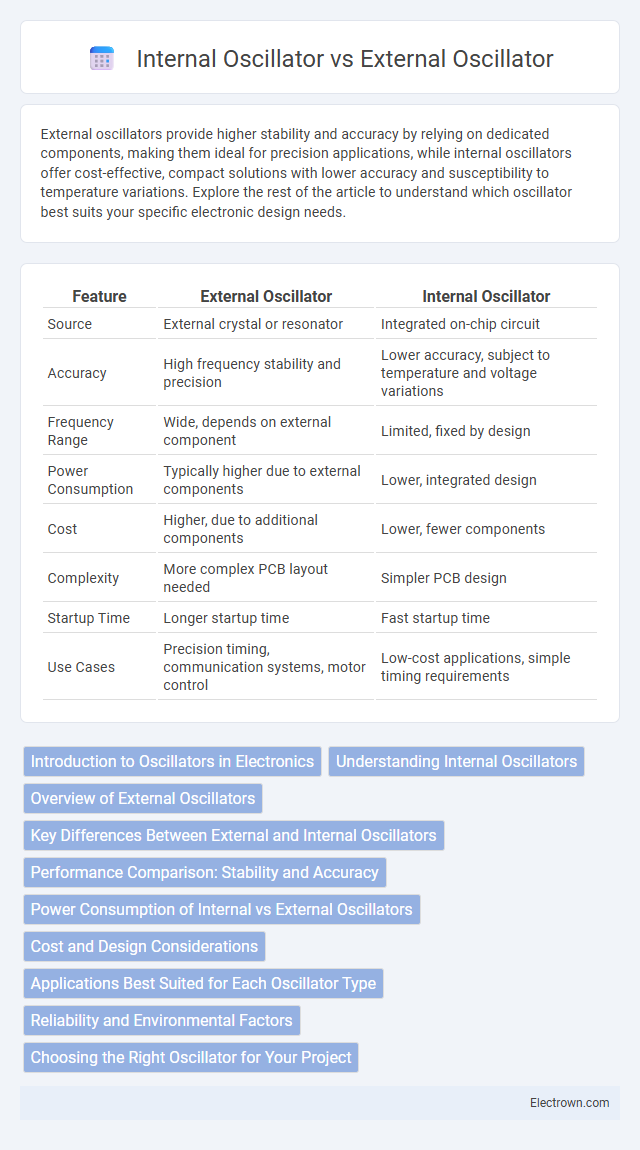External oscillators provide higher stability and accuracy by relying on dedicated components, making them ideal for precision applications, while internal oscillators offer cost-effective, compact solutions with lower accuracy and susceptibility to temperature variations. Explore the rest of the article to understand which oscillator best suits your specific electronic design needs.
Table of Comparison
| Feature | External Oscillator | Internal Oscillator |
|---|---|---|
| Source | External crystal or resonator | Integrated on-chip circuit |
| Accuracy | High frequency stability and precision | Lower accuracy, subject to temperature and voltage variations |
| Frequency Range | Wide, depends on external component | Limited, fixed by design |
| Power Consumption | Typically higher due to external components | Lower, integrated design |
| Cost | Higher, due to additional components | Lower, fewer components |
| Complexity | More complex PCB layout needed | Simpler PCB design |
| Startup Time | Longer startup time | Fast startup time |
| Use Cases | Precision timing, communication systems, motor control | Low-cost applications, simple timing requirements |
Introduction to Oscillators in Electronics
Oscillators in electronics generate repetitive signals essential for clock generation, timing, and frequency synthesis within circuits. An internal oscillator is integrated within a microcontroller or IC, offering convenience and reduced component count but often with lower frequency accuracy and stability. External oscillators, typically quartz crystals or ceramic resonators, provide superior precision and stability, making them ideal for applications requiring exact timing and minimal frequency drift.
Understanding Internal Oscillators
Internal oscillators, integrated within microcontrollers or processors, provide a cost-effective and compact timing source by generating clock signals without external components. They offer ease of use and lower power consumption but typically exhibit lower accuracy and stability compared to external oscillators, making them suitable for applications where precision timing is not critical. Understanding their frequency tolerance, temperature stability, and noise characteristics is essential for optimizing performance in embedded system designs.
Overview of External Oscillators
External oscillators provide precise and stable frequency signals by utilizing dedicated components such as crystal or ceramic resonators outside the microcontroller. These oscillators offer enhanced accuracy and reduced phase noise compared to internal oscillators, making them ideal for applications requiring reliable timing. Your system benefits from improved performance and consistency when integrating external oscillators, especially in communication and timing-critical devices.
Key Differences Between External and Internal Oscillators
External oscillators provide highly accurate and stable clock signals using dedicated components like crystal resonators, ensuring precise timing in critical applications. Internal oscillators are integrated within microcontrollers or devices, offering convenience and cost efficiency but with less frequency stability and accuracy. Your choice depends on balancing precision requirements with design complexity and power consumption constraints.
Performance Comparison: Stability and Accuracy
External oscillators provide superior stability and accuracy compared to internal oscillators due to their dedicated crystal or resonator components that minimize frequency drift caused by temperature and voltage variations. Internal oscillators, often integrated into microcontrollers, tend to have higher frequency tolerances and greater susceptibility to environmental fluctuations, leading to less precise timing. The enhanced stability of external oscillators is critical for applications requiring precise clock signals, such as communication systems and high-speed data processing.
Power Consumption of Internal vs External Oscillators
Internal oscillators typically consume less power than external oscillators due to their integrated design and lower complexity. External oscillators often require additional components and power to maintain stable frequency output, increasing overall power consumption. Your choice between the two should consider power efficiency requirements alongside performance needs in embedded system applications.
Cost and Design Considerations
External oscillators typically involve higher costs due to additional components like crystals or resonators, increasing both material and assembly expenses. Internal oscillators integrated within microcontrollers usually reduce overall design complexity and cost by eliminating the need for external parts, but they may offer lower accuracy and stability compared to external options. Choosing between the two depends on your priorities for precision versus budget constraints in your specific application.
Applications Best Suited for Each Oscillator Type
External oscillators excel in applications requiring precise frequency accuracy and stability, such as communication systems, high-speed data converters, and RF modules. Internal oscillators are best suited for cost-sensitive, low-power, and less timing-critical applications like microcontrollers, basic timing circuits, and low-frequency clock generation. Choosing between external and internal oscillators depends on the specific requirements for precision, power consumption, and environmental conditions.
Reliability and Environmental Factors
External oscillators offer higher reliability in environments with significant electromagnetic interference or temperature fluctuations since they are often shielded and calibrated for stability. Internal oscillators, while cost-effective and compact, may experience frequency drift due to thermal variations and voltage changes, potentially impacting timing accuracy. Choosing between external and internal oscillators depends on your specific application's sensitivity to environmental factors and the required frequency precision.
Choosing the Right Oscillator for Your Project
Selecting the right oscillator depends on your project's accuracy requirements and environmental constraints. External oscillators offer higher frequency stability and precision, ideal for applications demanding exact timing, while internal oscillators provide cost-effective and space-saving solutions with moderate accuracy. Evaluating factors like power consumption, frequency tolerance, and board layout will help determine whether an external or internal oscillator best fits your design needs.
External Oscillator vs Internal Oscillator Infographic

 electrown.com
electrown.com